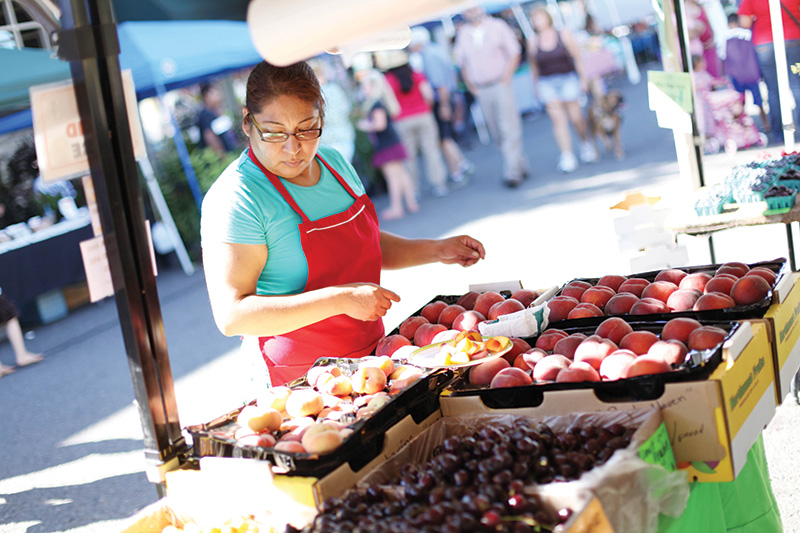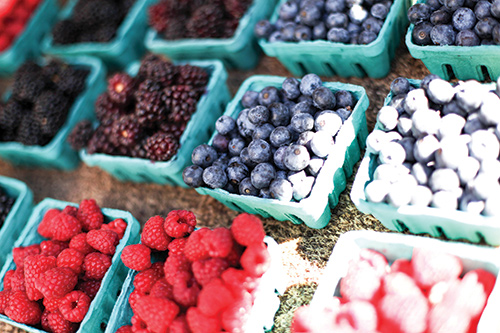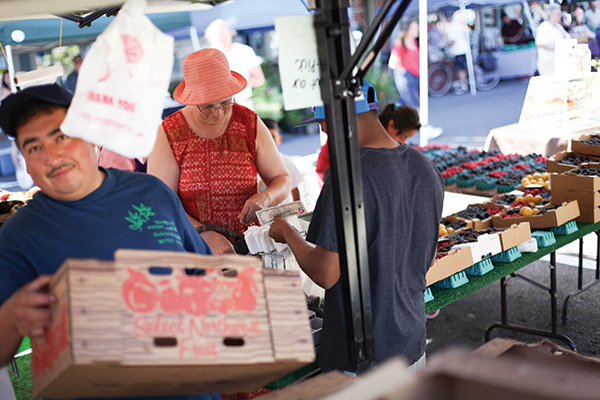Food for All

It came as something of a shock to realize that there were adults in his own community who didn’t know how to boil water.
“To our great surprise, there are just a lot of people who don’t know how to cook,” said Jeri Dobbs ’58. “There are kids who have grown up to 18 and never been in a stable home life and never had anybody show them how to cook.”
That lack of knowledge leads to hunger and waste.
“Too many people go to fast food and spend their money on food that is fattening and not very nutritious,” he said. “If they can go to the grocery store, know how to shop, look for ads in the newspaper, they can go and buy enough food to prepare a nutritious meal at a much lower price.
“If you teach someone how to cook, they can survive pretty readily on their own,” Dobbs said.
Jeri and his wife, Tricia, have been volunteering at the Oregon Food Bank (OFB) for more than a decade, ever since OFB opened its headquarters in northeast Portland back in 2001.
“We were looking around for various volunteer things, because we felt we wanted to give back,” Dobbs said. “We came and took the tour, and we were very impressed by it. We asked if there were any volunteer programs we could get involved with…and we’ve been coming here ever since.”
The Oregon Food Bank provides an array of resources throughout Oregon—and needs plenty of help. In the wake of the national recession and housing crisis, need in Oregon has increased dramatically, said Amber Young, a member of OFB’s communication team.
In 2010-11, the OFB Network distributed more than 1 million emergency food boxes, a 12 percent increase over the previous year and a record that OFB staffers never wanted to reach. That emergency food fed more than 260,000 people in Oregon and Clark County, Wash., a third of whom were children. At 29.2 percent, Oregon has the country’s highest rate of food insecurity among children.
"Students...are interested in how they can MAKE A DIFFERENCE or investigate what is going on or look upstream more."
–Kaely Summers '08
“That always hits home to me when I think about all this stuff we’re doing and why we’re doing it,” Young said.
Food distribution is, of course, a significant portion of OFB’s work. The food bank collects everything from surplus nonperishables and excess dairy, meat and produce from the food industry to USDA staples and food drive donations. That food is distributed throughout the OFB Network, which includes 20 regional food banks and 923 partner agencies, such as local food pantries, soup kitchens, churches and shelters.
But OFB’s mission isn’t just to feed the hungry today; it’s to end hunger and hunger’s root causes, a much harder prospect. Worldwide, one in seven people don’t have enough food to be healthy and active, according to the United Nations World Food Programme.

It’s about poverty, of course. It’s also about education—to meaningfully sustain a family income, to make healthy and affordable food choices, to safely store and prepare food, to access help when it’s needed or available.
It’s also about natural disasters and climate change, the impact of high gas prices and fuel shortages on agriculture and distribution, and the proliferation of foods that may fill stomachs without providing necessary nutrients.
At OFB, Young said, the work has to go beyond providing food in emergency situations; the organization also works on advocacy and education.
It’s in the latter that the Dobbs find their calling. They work with OFB’s nutrition education program, which—among other things—conducts six-week courses in healthy cooking for those in need. Students might include teen parents or adolescents transitioning out of foster care, adults in drug and alcohol rehabilitation, or people referred by partnering social services agencies. Volunteer chefs and assistants lead the classes, in which students prepare specific meals themselves then go home with the recipes and skills, and sometimes bags of ingredients, to make those meals for their families. The Dobbs spend hours every Monday at the OFB headquarters cleaning, sorting and packing kits of cooking utensils and staples, like spices, so the classes can be offered anywhere, from schools and community centers to apartment complexes.
They also have washed and folded laundry, repeatedly cleaned and organized the supply store room, helped set up the kitchen and education facilities at the OFB’s westside location and shopped for the courses, as needed, said Tricia Dobbs.
“There are just a myriad of things you can do,” she said. “When you hear the statistics about people’s food needs and how Oregon is one of, if not the most, food deficient in the country—every little bit counts.”
That’s what Kaely Summers ’08 calls “looking upstream” at the root causes of hunger and the factors that can help people move out of a cycle of poverty.
Summers got her introduction to hunger issues in middle school, when her Tacoma, Wash., church opened My Sister’s Pantry, now one of the largest food banks in the Tacoma area.
“It gave me a look at what’s really going on and made me think about priorities,” she said. “Every time I made a purchase, I was thinking how much food that could buy and feed how many people.”
As an international studies major at Pacific, she traveled extensively, getting a better sense of issues of poverty and hunger around the world. After graduation, she stayed on as an AmeriCorps VISTA volunteer, connecting the Pacific community with local food- and hunger-related projects. Today, she is the manager of the Forest Grove Farmer’s Market.
“Emergency food assistance is extremely important,” she said. “But we’re also looking at how people can be more self-sustaining.”
Pacific students, staff and faculty are actively involved in a number of projects, she said, including alternative fall and spring breaks where students work in San Francisco and Tacoma (including at My Sister’s Pantry). Staff members volunteer with the Forest Grove Summer Food Program, which feeds free lunches to students in local parks when school meals are unavailable.
“I think students are becoming more aware of (hunger) with the recession and with it being more out in the open. People who have never been homeless before or who have gone through foreclosures or are now newly hungry—these issues are popping up more and more,” Summers said. “Students aren’t blind to that and are interested in how they can make a difference or investigate what is going on or look upstream more.”
Students helped start the Give and Go project, run by the Center for Civic Engagement, to recycle unwanted
household items, including food, when students move off campus in the spring. And, students have worked hard to develop relationships with the dining services company that provides meals in the University Center and at University events—they work to reduce waste, compost food scraps and collect unused food to be delivered to food pantries and shelters.
“What I found at Pacific is that when there’s student energy behind it and passion for making change, it may take a little bit of direction, but students want change and push for that and oftentimes it’s very successful,” Summers said.
An example is a gleaning program in the Forest Grove area. Leda Glastonbury ’12 grew up in the hills near Glide, Ore., “off the grid” until she was 10. A lifelong vegetarian, Glastonbury got something of a reputation among her Pacific friends for her love of fruit.
“I’ve always been really into food. There are pictures of me as a little kid petting strawberries,” she laughed, adding that the “spirit of Leda” is the ubiquitous Northwest blackberry. “I’m just a super-duper fruity lady.”
When she came to Pacific, she planned to study sociology or social work— the “people side” of hunger.
Then, “I had an epiphany one night, when someone was talking about a quince.” (That’s a fruit similar to an apple or pear, but native to southwest Asia.) “I was having another conversation with someone else, but I kept getting distracted; I was so excited to talk about food.”
She signed up for Pacific’s permaculture class, became an environmental studies major and ultimately completed her senior project by establishing a gleaning program that collected and donated otherwise unharvested fruit.
Under Glastonbury’s direction in October 2011, volunteers completed two harvests, giving the best quality apples and pears to area charities and splitting the rest between the volunteers and the homeowners who donated their fruit.
“I just want to get the fruit in the mouths,” rather than rotting on the ground, she said.

She added she would like to see the program continue, expanding to involve the recipients of the donated food in the harvest process and also to include education for fruit tree owners on better tree care, which could lead to more productive harvests.
Both expansions, really, would be part of what Summers said is called “food sovereignty,” or the creation and ownership of your own food.
Summers first learned of the notion on a study abroad trip to the Amazon region of Ecuador the summer after her freshman year at Pacific. She said the people who students visited were extremely poor but still never worried about going hungry with the abundance of food produced by the rainforest. As outsiders came in, though—particularly big companies interested in drilling oil, building pipelines or patenting seeds—the people worried about losing their food sovereignty.
In reality, few people in the industrialized world are truly food sovereign, a fact that concerns environmental science Professor Deke Gundersen. He teaches and lives permaculture—a system that mimics nature, both in sustainable food production and in many other social and cultural systems—and worries about the day that fuel stores run out and the food distribution systems we depend on fail.
“Right now, we have really good access to food, and we’re still not doing it very well. We can get food from anywhere in the world, and what do we choose to do?” (Eat fast food.)
“I think we need to get back to eating locally, eating what’s really available. Once the fossil fuel economy ends, you’re not going to be able to have that mango grown in Mexico,” he said.
His home in Forest Grove features 18 fruit trees, a myriad of berries, herbs and raised-bed vegetable gardens. (At least, it did early this summer—his family is moving to a plot with more acreage and starting a larger home permaculture project.)
He also is a faculty director for the B Street Permaculture Project, a sort of learning lab for sustainability at Pacific. About 80 percent of the project is food-related, with students growing about a half-acre of crops, raising chickens and investigating sustainable agriculture, building and design. Students get involved through gardening, permaculture, science and art classes, and often turn their learning into education for others. Education students get involved with the learning garden at the B Street site, helping younger children learn food-growing skills that will help them sustain themselves for life, Summers said.
"There are just a myriad of things you can do. When you hear statistics about peoples food needs and how OREGON is one of, if not the most deficient in the country–every little bit counts."
–Tricia Dobbs
Many students who work at B Street also get involved with local community gardens, like Life & Sol, which is open to students, staff and faculty, as well as the Forest Grove community, and at the Maple Street Victory Garden, where low-income families particularly can get affordable access to garden space, water, tools and plant-care education to grow their own food.
“It’s really empowering for people to be in charge of their own food that gives them nutrition and doesn’t harm the earth,” Glastonbury said. “It’s so empowering and fun to be able to grow your own food.”
Adelante Mujeres, a nonprofit organization in Forest Grove that works to educate and empower low-income Latina women and families also provides instruction in organic agriculture. Women who graduate from the program may grow their own food at home or in the community gardens, or they may participate in La Esperanza Farm, a 12-acre certified organic farm, where they get a small plot to grow items they can, in turn, sell.
Among the venues for their goods is the Forest Grove Farmer’s Market, managed by Summers. It serves as a business incubator for women in Adelante Mujeres’ education programs, as well as a community gathering place and source of healthy, affordable food.
Summers said the market strives to be open to everyone. The vendors accept not only debit and credit cards, but also food stamps and other assistance vouchers. Families on WIC or senior citizen farm-direct nutrition program assistance can not only use their fresh fruit and vegetable vouchers at the market, they can get a $10 match to make those vouchers go farther.
The market also sometimes teams up with the Oregon Food Bank to offer Shopping Matters courses—yet another educational resource—to help people select cost- and nutrient-effective foods. Summers hopes to bring master food preservers to the market, as well, to help those who are learning to grow their own food find ways to make it last throughout the year.
“We’re thinking of not only feeding people and getting nutrients into people but trying to look upstream a bit. You can’t just focus on emergency pieces—we need to be giving people the resources and tools to produce their own food,” she said.
It’s an incredibly complex, incredibly daunting battle, tackling hunger locally, let alone around the world, she said.
“These are huge issues, and I think about them all the time,” Summers said. “But there are so many people that are doing incredible things throughout the country and throughout the world on these issues, so it doesn’t always seem like you’re the only one working at it.
“You just have to keep eating and keep doing your part in whatever you can.” ■
This story first appeared in the Fall 2012 issue of Pacific magazine. For more stories, visit pacificu.edu/magazine.



